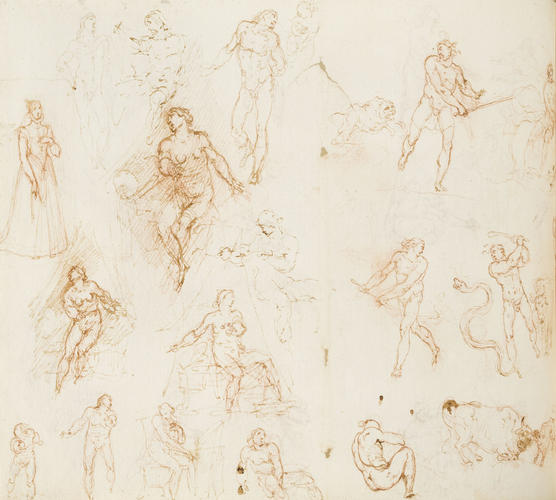Recto: Neptune, Lucretia, centaurs, satyrs, male nudes. Verso: Lucretia, Annunciation, Rape of Europe, male nudes, various other studies. Verso: Lucretia, Annunciation, Rape of Europe, male nudes, various other studies c.1585-95
Pen and ink over red chalk | 20.1 x 18.5 cm (sheet of paper) | RCIN 906952

Giovanni Ambrogio Figino (1548/51-1608)
Recto: Neptune, Lucretia, centaurs, satyrs, male nudes. Verso: Lucretia, Annunciation, Rape of Europe, male nudes, various other studies. Verso: Lucretia, Annunciation, Rape of Europe, male nudes, var c.1585-95


-
Recto: Two studies of Neptune driving his chariot drawn by sea-horses, one framed, two studies of Lucretia alive and one already dead in her bed, two studies of centaurs, three of satyrs, and various studies of male nudes standing, reclining, running. Verso: Three studies of Lucretia, one study of the Rape of Europa, one study of Hercules attacking a serpent, one of a man being chased by a dog, one full-length study of a woman in sixteenth-century costume, one study of a single bull and one of a bull and a calf or dog, one study of a seated male nude holding a book, two studies of standing male nudes, perhaps a study of the Annunciation, various other studies.
The fold in the middle of this sheet, together with the holes, indicate that it was originally part of a sketchbook that was dismantled. RCINs 906952 and 906954 can be identified as two further sheets from the same sketchbook. Although it is impossible to reconstruct the order of the three sketchbook pages, Figino appears to have used each sheet in a sequential manner. Similar subjects can be found on each of the three sheets, showing that new ideas were spilling from his pen.
In this case the recto was probably done before the verso, as the figure of the standing male nude, perhaps a study for Apollo appears reversed on the verso without the red chalk under drawing – a strong indicator for that Figino had traced it through from the recto.
Figino framed the composition of Neptune in the bottom left corner twice: the first time including the horse on the left. He then reconsidered the composition and added a triton blowing a shell. His drawing of a full composition for Neptune is likely to have been inspired by a drawing of Neptune on his chariot in red chalk that was in Figino's possession and is now at the Accademia Carrara in Bergamo. This drawing was probably based on a drawing of Neptune by Leonardo da Vinci for his friend Antonio Segni, which is now lost. The Bergamo drawing has been claimed as at least a partial copy of Leonardo’s design, and the upper part of Neptune and the horses to the right there are very similar to those in the Windsor drawing (RCIN 912570), which has generally been regarded as preparatory for Segni's drawing of Neptune.
The Bergamo drawing bears an attribution to Michelangelo. In a letter from 19th June 1768 to Giovanni Bottari from Giacomo Carrara, who had bought the Bergamo drawing, says that, on the top, his drawing bears an inscription that mentions Figino as having owned this drawing: 'Questo Nettuno, disegno originale di Michelagnolo Bonarotta, pervenne in mano di Gio. Paolo Lomazzo: fu poi l'anno 1578 conservato da Gio. Ambrogio Figino per esser stato suo maestro, e finalmente dal detto Figino lasciato l'anno 1608 al sig. Ercole Bianchi …' (Letter printed in Raccolta di Lettere, Vol. VI (1768), pp. 332-3). None of Figino's drawings in Windsor is a direct copy of the Bergamo drawing, but variations of the theme.
Figino's drawings of Neptune and his chariot, seen from the side, seem to be connected to a maiolica plate in the Victoria and Albert Museum (C.2266-1910). The arrangement of both is very close to the Tyszkiewicz gem the Boston Museum of Fine Art 27.733).
For other studies for Neptune by Figino in the Royal Collection see RCINs 906939v, 906945, 906949rv and 906959r. For other studies of Lucretia by Figino in the Royal Collection see: RCINs 906935, 906948, 906949rv, 906950, 906954r and 906955.
The female figure in sixteenth-century costume on the verso appears on RCIN 906938 and 906963v and might be a study for a portrait, as it is one of the rare drawings of figures dressed in contemporary costume.
Inscribed in pen at lower right: No81 MichelAngelo
Provenance
Bequeathed by the artist to Ercole Bianchi in 1608; in the collection of Consul Joseph Smith by 1755; purchased by George III in 1762. Recorded in 'Inventory A', p. 117: '110 Mostly sketches after the Old Masters Raphael, Michel Angelo &c.a.'
-
Creator(s)
-
Medium and techniques
Pen and ink over red chalk
Measurements
20.1 x 18.5 cm (sheet of paper)







